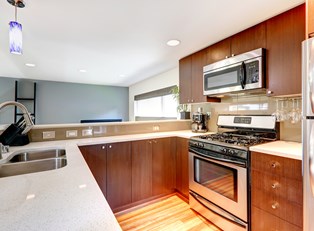Home remodels are a good way to freshen up your home or add the finishing touches to a new house. However, when considering home renovations, you may be turned away by the daunting price tag that comes with a remodel. If you are considering a remodel, here are 10 ways you can save some money.
- DIY options
The easiest way to save money on a remodel is to do the work on your own. This eliminates the pricey contractor fees that can be the bulk of a remodel cost. A common contractor markup is around 25%, which means a $10,000 job would cost $12,500 if you hire a contractor to do the work. It is easy to avoid this extra expense by doing some of the simpler jobs on your own. A good example would be tile flooring, which is fairly easy to install with some research, and is relatively inexpensive. For example, a tile bathroom of about 32 square feet might bring your total cost to about $1,050, including the removal of the old floor. With a contractor you would have to pay this cost, plus labor, plus warranties, plus the contractor markup. - Material choices
Choosing materials can be difficult for a home remodel because you are trying to balance looks with durability. To save money, choose materials that achieve the desired aesthetic but are cheaper than the material you may have originally wanted. For instance, granite tile is much cheaper than solid granite for countertops. A granite slab can cost anywhere from $80 to $150 per square foot, but you can find granite tiles for up to 75% cheaper. Reclaimed materials can save you money too, if you are willing to go looking for them. - Upcycling
Upcycling is the use of old furniture for new purposes. Use an old dressing table as a sink vanity or even make new furniture from used materials. Buying a new nightstand might cost around $100 (depending on the brand and store), but you can upcycle some old bathroom cabinets into a personalized nightstand for just the cost of some wood scraps (which you can find for $50 or less). - Examine your needs
When beginning a remodel, it can be easy to get carried away. Examine what you really want and need to change in your home before you commit to the budget. If you want more storage space in the kitchen, simple wire racks in your cabinets will be exponentially cheaper than restructuring your entire kitchen. - DIY Demolition
If are comfortable with it, consider doing your own demolition. Knocking down your own kitchen cabinets can remove a significant cost from a professional contractor bill, sometimes up to $1000. However, if you need to demolish some walls, consider going for the contractor option so you don’t change the stability of your home. - Consider your fixtures
Remodeling is more than choosing where walls go and what paints to use, so keep in mind the smaller things like lighting that may go unnoticed in your plans. Not all installed fixtures cost the same. For example, recessed lighting can cost upwards of $225, while normal fixtures cost little more than the light itself (generally about $150). - Consider contracting peak seasons
Like many businesses, there are peak seasons for contractors. Take a look at what the busiest times for contractors may be for your area and be aware of what this season can mean for your project. Busy seasons often mean higher prices as contractors compete for materials and have less time to work. - Know your local building codes
Being familiar with local building codes can help you avoid doing unnecessary work on your home. Additionally, it can help you avoid not doing enough. It can be a tough pill to swallow if you finish a renovation and find you need to do additional work (with more of your money) to make your home up to code. - Avoid moving too much
If you can avoid moving any plumbing or too much electrical wiring it can save a ton of money. Plumbing especially can cost upwards of $500, so try to plan a remodel while keeping your current plumbing fixtures in place. - Settle on decisions
This is especially true if you are hiring a contractor. Always know in advance exactly what you would like done to your home. Changing plans midway through a remodel can become costly with contractors, especially if a change brings an unplanned delay.



